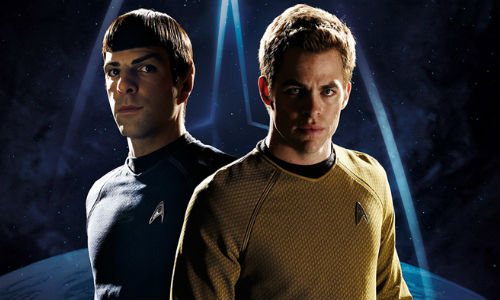
Star Trek Into Darkness is that glorious rarity among movies.
It is a sequel worth seeing.
Not only worth seeing but subsuming yourself into as if you too are an inhabitant of the 23th century along with Kirk, Spock and the rest of the iconic Enterprise crew who return for a second action-filled adventure in J. J. Abrams’ re-imagined Star Trek universe.
In fact so complete is the world-building that Abrams employs, and so judicious his use of special effects and 3D – it this case, it serves the greater needs of the film rather than the other way around; Spock would approve I’m sure – that it is hard not to feel like you are walking the streets, and flying along the roads, in hover cars no less, of futuristic London and San Francisco (which sustain quite a bit of damage at various points in the film).
His creation of the class M world of Nibiru, populated by a pagan people who have “barely invented the wheel”, where the film kicks off with an energetic chase scene through distinctly otherworldly towering red flora, is impressive too.
In every respect, Abrams has created a visually impressive universe where the buildings, the landscapes and the awe-inspiring sweep of the galaxies are so real and tangible that it feels like a flesh-and-blood universe that real people struggling with real world-altering dilemmas could inhabit, glittering and futuristic though it clearly is.

And that is one of the movie’s great strengths.
That is largely because it allows larger-than-life characters like Kirk (Chris Pine), and Spock (Zachary Quinto), Uhura (Zoë Saldaña) and Scott (Simon Pegg) and the other members of the Enterprise crew, who could potentially look cartoonish and overwrought in a less thoughtfully-realised world, to come across as people with feet of clay even as they perform the sort of feats that make mere mortals look on with awe.
In other words, though they do save planets, galaxies and yes even Starfleet itself, the fact that they are anchored in a universe where lovers quarrel (Spock and Uhura), parents agonise over the ill-health of a child, and yes still have to commute to work, lends their fantastical adventures in a hyper technologically-advanced future, a realism, and relatability, they might otherwise lack.
And that realism is important.

It means that when Kirk and his devoted crew, played by the same ensemble cast that made the original re-booted Star Trek (2009) such a rich viewing experience, set off in pursuit of alleged terrorist and ex-Section 31 shadowy operative, John Harrison (Benedict Cumberbatch, who plays the villain with all of the gravitas and none of the melodrama it requires), right into the heart of enemy territory, the Klingon homeworld of Kronos, they are motivated as much by vengeance and retribution as they are by noble ideals of justice and fairplay.
We are not watching perfectly-realised automatons, all ideals and zero flaws do battle but rather real human beings, struggling
Yes they are racing across the far reaches of our galaxy, battling Klingons and rogue elements spawned from the heart of a conspiracy that runs into the heart of Starfleet itself, but they are real people in real relationships, and it is this balance between the real and the fantastical that lends Star Trek Into Darkness much of its emotional heart and resonance.

It is relationships after all that have always been at the heart of the Star Trek universe, specifically that of Kirk and Spock, and Abrams is faithful to that, keeping these two central figures, who squabble much like two brothers would, at the heart of the action at all times.
Thankfully it is action, some of the sequences of which are heart-in-your-mouth dazzling, that is underpinned by an intelligence and thoughtfulness lacking from many other blockbusters of this ilk.
Abrams has remembered that Star Trek has always been the thinker’s franchise, wrestling with the big issues such as power, and its use and abuse, war and its destructive aftermath, and the tension between the need for any society to protect and perpetuate itself without sacrificing the very rights, freedoms and ideals that gave birth to it in the first place.
And so it remains in Star Trek Into Darkness where grand themes of vengeance and justice, war and peace, and the means, legitimate or otherwise needed, to safeguard the latter facets of any advanced society are countenanced freely without becoming overbearing.
Again though Abrams keeps the intellectual underpinnings and the pell-mell action finally balanced ensuring that while you are taken on a wild roller coaster ride across worlds and cities, civilisations and planets, you never once lose sight of why you are on this furious journey.

Spock and Kirk share the unshakeable bonds of brotherhood, bonds that are tested severely but do not yield in “Star Trek Into Darkness” (image via nerdrepository.com)
It’s this merry marriage of the expansive and the intimate, of grand themes of love and war, friendship and enmity that power Star Trek Into Darkness, a smart, handsome movie that doesn’t lose sight, even for a second, of the fact that truly engrossing action has at its heart an intelligence and humanity or it is all for nought.
It may be bold to say this but Star Trek Into Darkness is as close to perfect as a film can get, faithful to its antecedent series but willing to twist, bend and yes break the franchise at times in pursuit of grand storytelling beautifully told.